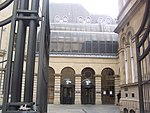National Museum of Scotland

The National Museum of Scotland in Edinburgh, Scotland, was formed in 2006 with the merger of the new Museum of Scotland, with collections relating to Scottish antiquities, culture and history, and the adjacent Royal Scottish Museum (opened in 1866 as the Edinburgh Museum of Science and Art, renamed in 1904, and for the period between 1985 and the merger named the Royal Museum of Scotland or simply the Royal Museum), with international collections covering science and technology, natural history, and world cultures. The two connected buildings stand beside each other on Chambers Street, by the intersection with the George IV Bridge, in central Edinburgh. The museum is part of National Museums Scotland. Admission is free.The two buildings retain distinctive characters: the Museum of Scotland is housed in a modern building opened in 1998, while the former Royal Museum building was begun in 1861 and partially opened in 1866, with a Victorian Venetian Renaissance facade and a grand central hall of cast iron construction that rises the full height of the building, design by Francis Fowke and Robert Matheson. This building underwent a major refurbishment and reopened on 29 July 2011 after a three-year, £47 million project to restore and extend the building led by Gareth Hoskins Architects along with the concurrent redesign of the exhibitions by Ralph Appelbaum Associates.The National Museum incorporates the collections of the former National Museum of Antiquities of Scotland. As well as the national collections of Scottish archaeological finds and medieval objects, the museum contains artefacts from around the world, encompassing geology, archaeology, natural history, science, technology, art, and world cultures. The 16 new galleries reopened in 2011 include 8,000 objects, 80 per cent of which were not formerly on display. One of the more notable exhibits is the stuffed body of Dolly the sheep, the first successful cloning of a mammal from an adult cell. Other highlights include Ancient Egyptian exhibitions, one of Elton John's extravagant suits, the Jean Muir Collection of costume and a large kinetic sculpture named the Millennium Clock. A Scottish invention that is a perennial favourite with school parties is the Scottish Maiden, an early beheading machine predating the guillotine. In 2019, the museum received 2,210,024 visitors, making it Scotland's most popular visitor attraction that year.
Excerpt from the Wikipedia article National Museum of Scotland (License: CC BY-SA 3.0, Authors, Images).National Museum of Scotland
Chambers Street, City of Edinburgh Old Town
Geographical coordinates (GPS) Address Website External links Nearby Places Show on map
Geographical coordinates (GPS)
| Latitude | Longitude |
|---|---|
| N 55.946944444444 ° | E -3.19 ° |
Address
National Museum of Scotland
Chambers Street
EH1 1JF City of Edinburgh, Old Town
Scotland, United Kingdom
Open on Google Maps









